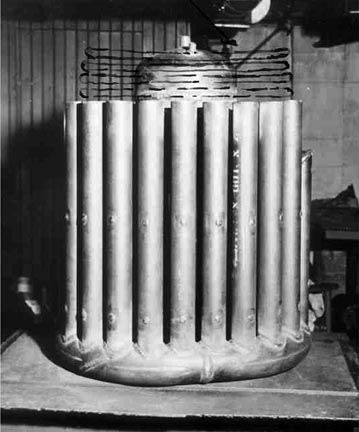Peterson Boiler
 |
 |
The photos accompanying this posting all come from Kelly R. Williams out of Pennsylvania where he hangs out with the Tom Marshall Museum people of FAHP in Delaware. Kelly has a Stanley Register Online called www.stanleyregister.net and it has 802 listings of Stanleys from all over the world. Some may be duplicates. It is not easy collecting all of this information and getting it accurate. Over the years some vehicles have been put together from bits and pieces and some have been completely fabricated. Wooden frames, leather upholstery, and sheet |
| metal bodies tend to deteriorate in the nearly 120 years that some of these vehicles have been made. Anyone with more Stanley information is encouraged to contact Kelly. He has tried to be as accurate as possible. | ||
|
||
(Note: Click on a picture to see a larger view and then use your browser to enlarge it further.) |
||
| The Peterson boiler and original gun burner as it came to the shop in a 10 hp. Stanley from Kalamazoo. Tubes show some scaling from over-heating. Hydro testing to 3,000 psi was successful. |
 |
All in all the boiler accomplished what it was supposed to do. It replaced a Stanley original boiler and fit in the same place. It could be fabricated by conventional welding. The burner was either off the shelf or simply fabricated from available parts—kerosene pump, sparker, squirrel cage fan. It did not scorch like a Stanley boiler will do. By burning a few more gallons of kerosene per hour one could make steam and go places. |
|
|
|
Harry O. Peterson and the boiler for a condenser Stanley. |
|
 |
The reason for my interest in Peterson boilers is because we worked on a 1909 Stanley that the original restorer, H. W. Waber of Kalamazoo, Michigan, had installed a Peterson boiler into. It was good fun to work with a water level boiler after all of these years attempting to control a monotube. We installed a modern gun burner with permanent magnet electric motor and it fired up from cold in five minutes. For controls we had an electric pressure transducer and water level sensor. I know it was cheating compared to operating an original Stanley but it was so easy and fun. | |
H. W. Waber, Kalamazoo, Michigan and his 1909 Stanley |
Note: Harry Peterson (we believe) is working on Bob Lyon's Locomobile that was restored about 1950 by Richard French. |
 |
||





